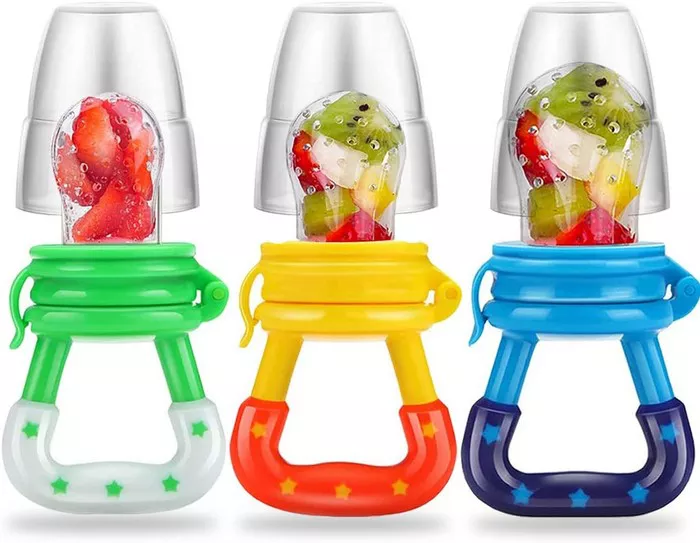As a parent, ensuring the health and safety of your child is paramount, especially during the critical stages of early development. Teething is a significant milestone in a baby’s life, often accompanied by discomfort and a natural inclination to chew on objects for relief. Teether feeders offer a safe and hygienic solution to this challenge, allowing infants to explore different textures and tastes while soothing their gums. However, selecting the appropriate foods to place in a teether feeder is essential for both safety and nutritional value. In this guide, we will explore the best options for filling your teether feeder, considering factors such as age appropriateness, nutritional content, and allergen concerns.
Understanding Teether Feeders:
Before delving into the specifics of what foods to put in a teether feeder, it’s essential to understand the purpose and design of these devices. Teether feeders typically consist of a silicone or mesh pouch attached to a handle, allowing babies to safely gnaw on various foods without the risk of choking on large pieces. The mesh or silicone material acts as a barrier, preventing chunks of food from breaking off while still allowing infants to extract flavor and nutrients through gentle sucking and chewing. This design makes teether feeders an excellent tool for introducing solids to babies who are transitioning from breastfeeding or formula.
Age Appropriateness:
When choosing foods for your teether feeder, it’s crucial to consider your baby’s age and developmental stage. While teething can begin as early as three months of age, most babies don’t start using teether feeders until they are around six months old and have developed the motor skills necessary to hold and manipulate the device. At this stage, babies are typically ready to experiment with a variety of flavors and textures, making teether feeders an exciting opportunity to introduce them to new foods.
Soft and Malleable Foods:
One of the key principles when selecting foods for teether feeders is to choose items that are soft, easily mashable, and unlikely to pose a choking hazard. Soft fruits such as bananas, avocados, and ripe peaches are excellent choices, as they can be mashed or pureed to a smooth consistency that is safe for babies to consume. Additionally, cooked vegetables like sweet potatoes, carrots, and squash can be steamed or boiled until tender and then mashed or diced into small pieces for use in teether feeders.
Nutritional Content:
In addition to being safe for babies to eat, the foods you place in a teether feeder should also provide essential nutrients to support their growth and development. Fruits and vegetables are rich in vitamins, minerals, and antioxidants, making them ideal choices for teether feeders. Opt for a variety of colors to ensure a diverse range of nutrients, and consider incorporating leafy greens like spinach and kale for added nutritional value. You can also experiment with different flavor combinations to stimulate your baby’s taste buds and encourage them to explore new foods.
Allergen Concerns:
When introducing new foods to your baby, it’s essential to be mindful of potential allergens that could trigger an adverse reaction. Common food allergens include milk, eggs, peanuts, tree nuts, soy, wheat, fish, and shellfish. While these allergens are less likely to cause a reaction when placed in a teether feeder due to the minimal exposure, it’s still wise to exercise caution, especially if you have a family history of food allergies. Consider consulting with your pediatrician before introducing allergenic foods to your baby, and monitor them closely for any signs of discomfort or allergic reaction.
Hygiene and Safety:
Maintaining proper hygiene is crucial when using teether feeders to prevent the risk of contamination and foodborne illness. After each use, thoroughly wash the teether feeder with warm, soapy water, paying special attention to the mesh or silicone pouch where food residues may linger. Allow the teether feeder to air dry completely before storing it in a clean, dry place. Avoid leaving food in the teether feeder for extended periods, as this can promote bacterial growth and spoilage. Additionally, regularly inspect the teether feeder for signs of wear and tear, and replace it if the mesh or silicone becomes damaged to prevent choking hazards.
Conclusion:
Teether feeders are a valuable tool for soothing teething discomfort and introducing babies to a variety of nutritious foods. By selecting soft, age-appropriate foods with high nutritional value and being mindful of potential allergens, you can provide your baby with a safe and enjoyable feeding experience. Remember to prioritize hygiene and safety when using teether feeders, and consult with your pediatrician if you have any concerns about your baby’s diet or development. With careful consideration and guidance, teether feeders can be a valuable asset in supporting your baby’s journey towards healthy eating habits and overall well-being.


